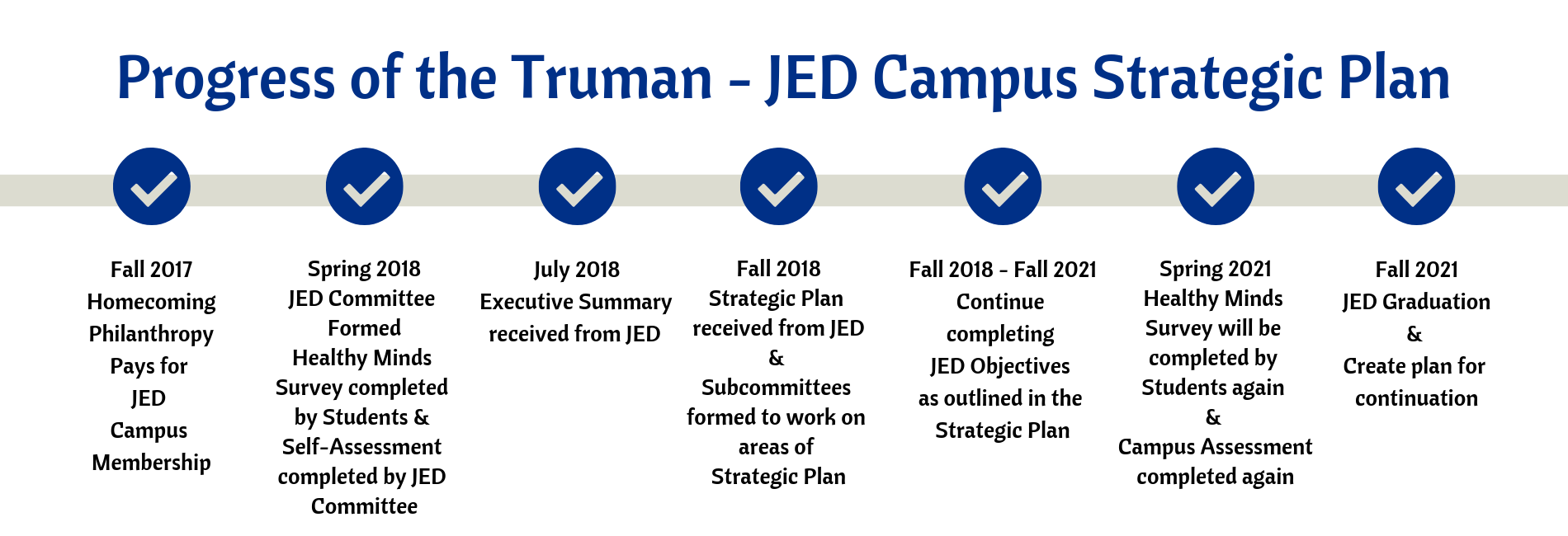

What is JED?
JED Campus is an initiative of JED designed to guide schools through a collaborative process of comprehensive systems, program and policy development with customized support to build upon existing student mental health, substance abuse and suicide prevention efforts. JED Campuses embark on a four-year strategic partnership with JED that not only assesses and enhances the work that is already being done, but helps to create positive, systemic change in the campus community.
How does it work?
JED Campus uses proprietary assessments to understand each school’s programs, systems and challenges. After completing the initial assessment, a JED Campus receives feedback and recommendations based on their responses and informed by student data gathered on their campus by the Healthy Minds Study. Our JED Campus team then works with the school to develop a strategic plan for implementation over their four years in the program. While executing the strategic plan, JED Campuses are provided with ongoing support and technical assistance from a dedicated JED Campus Advisor. JED Campuses also have the opportunity to share information and resources with other schools in the program through our Learning Community, which includes webinars, newsletters, and online resource center, and a discussion forum.
JED – Updated Language
Undetermined self-directed violence: Deliberate and intentional behavior directed at oneself that results in injury. Evidence is unclear to indicate suicidal intent.
Suicidal self-directed violence: Deliberate and intentional behavior directed at oneself that results in injury. Evidence is present to indicate suicidal intent.
Suicide attempt: Non-fatal, deliberate and intentional behavior directed at oneself with the intent to die. A suicide attempt may or may not result in injury.
Suicide: Death that occurs due to self-directed injurious behavior with the intent to die from such behavior.
Interrupted self-directed violence, by self or other: Deliberate and intentional behavior directed at oneself that is stopped by self or another. Interruption may occur after the initial thought or after onset of self-directed behavior.
Other suicidal behavior including preparatory acts: Behaviors in preparation towards making a suicide attempt, prior to potential for harm occurring. This may include behaviors beyond verbalization or thoughts of suicide, such as acquiring means or methods, or preparing for one’s death.
Successful suicide: This terminology implies a desired outcome whereas those involved in the mission of “reducing disease, premature death, and discomfort and disability” (J. Last, Dictionary of Epidemiology 1988) would view this event as undesirable. Correct term: suicide
Failed attempt: This terminology gives a negative impression of the person’s action, implying an unsuccessful effort aimed at achieving death. Correct terms: suicide attempt or suicidal self-directed violence.
Non-fatal suicide: This terminology portrays a contradiction. “Suicide” indicates death has occurred due to self-directed behavior; “nonfatal” indicates that no death occurred. Correct term: suicide attempt.
Parasuicide: Term previously used to describe a person’s self-directed violence regardless of intention of death. The World Health Organization recommends the term “suicide attempt”. Correct terms: non-suicidal self-directed violence or suicidal self-directed violence.
Suicidality: This terminology is often used to refer to either suicidal thoughts and suicidal behavior. They differ in occurrence, contributing factors, consequences and interventions methods, and should be addressed differently. Correct terms: suicidal thoughts and suicidal behavior.
Suicide gesture, Manipulative act, and Suicide threat: These terms portray a value judgment and offer a negative impression of a person’s intention. They typically describe incidents of nonfatal, self-directed violence. Correct terms: non-suicidal self-directed violence or suicidal self-directed violence.
For more information available to the Truman community, such as the Town Hall Meeting, log into TruView and go to https://truview.truman.edu/pages/jed-campus-program.


